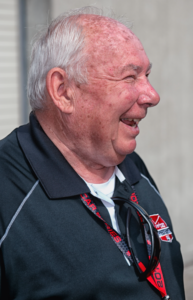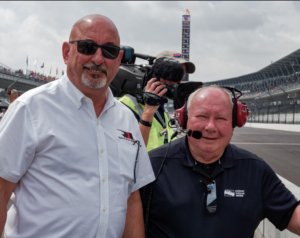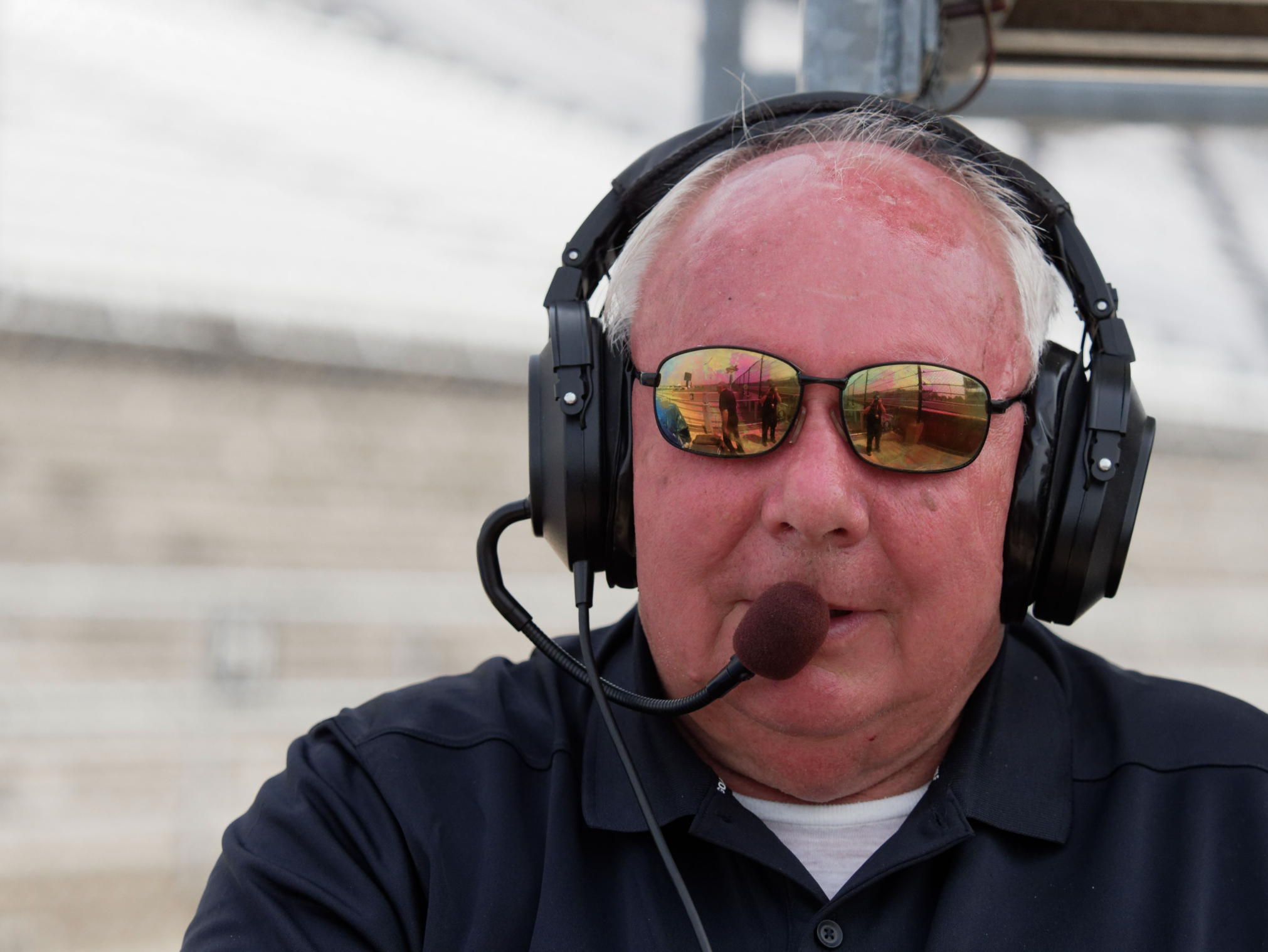Glenn Timmis Celebrates 50 Years of Working the Indy 500 and Many Other Races
Photography Provided by Fred Kurtz
Raised in Fort Wayne, Indiana, Glenn Timmis had what some might describe as the perfect childhood. Glenn’s dad traveled five days a week, but his next-door neighbor was Ernie Flowers, the right-fielder for the professional men’s fast-pitch softball team, the Fort Wayne Zollner Pistons. Across the street lived Harry Burden, a car salesman who did some race-car driving at the local level.
 “Since dad was gone during the week, if Ernie wasn’t taking me to a ball game, Harry was taking me to a race,” says Glenn, now 84. Not surprisingly, Glenn developed an affinity for both sports but took a particular shine to the racetrack. In the 1940s his dad would take him to the Indianapolis 500 qualifications. He didn’t attend his first Indianapolis 500 race, however, until 1956 when he was a senior in high school. He attended 10 Indy 500 races as a spectator before he began working at the racetrack. In 1970 Glenn became an observer, a track official whose job entails standing next to the track wall with a headset and being the eyes and ears for race control.
“Since dad was gone during the week, if Ernie wasn’t taking me to a ball game, Harry was taking me to a race,” says Glenn, now 84. Not surprisingly, Glenn developed an affinity for both sports but took a particular shine to the racetrack. In the 1940s his dad would take him to the Indianapolis 500 qualifications. He didn’t attend his first Indianapolis 500 race, however, until 1956 when he was a senior in high school. He attended 10 Indy 500 races as a spectator before he began working at the racetrack. In 1970 Glenn became an observer, a track official whose job entails standing next to the track wall with a headset and being the eyes and ears for race control.
“Essentially you’re an extension of safety, making sure the track is clean and that no issues arise,” says Glenn, a Hendricks County resident.
The Indianapolis Motor Speedway has 15 observer stations, usually with two to a station. Observers are not to be confused with spotters, who work for the race teams to keep their drivers informed of their surroundings during a race. In 1971 Glenn worked for the United States Auto Club (USAC), the sanctioning body at the time for the Speedway. When Glenn worked with the USAC, it was a volunteer organization.
“I was never paid a dime from USAC,” he says. “They gave us a meal ticket, but the cafeteria line was always too long to ever use it.”
He didn’t earn a wage at the Speedway until the Indy Racing League (IRL) took over in 1996, which later morphed into IndyCar in 2008. With the IRL, Glenn traveled to racetracks across the country including the Texas Motor Speedway in Fort Worth.
“I saw some great racing there,” he says. “When that green flag dropped, you held your breath until the end of the race. That was a cool racetrack and different from Indy because you could see all the way around it.”
He traveled to Japan seven times.
“That racetrack was super unique,” he says. “It was essentially on top of a mountain. Honda chopped off the top of the mountain and built a racetrack. It was an engineering marvel.”
Unfortunately, it was destroyed by a tsunami several years ago.
It’s hard for Glenn to single out a favorite race.
“I can’t tell you the number of races where the winner was a blink of an eye,” he says. “A lot of them, you could throw a blanket over a dozen cars that were so close they could have shaken hands with each other.”
In October of 2011, Glenn was working as an observer at the Las Vegas Motor Speedway. He found an open space at the fence so he moved down to have a better line of vision.
“I saw two cars start to get a little bit out of shape at the end of turn two, so I got on the headset and said, ‘I have two cars,’” Glenn recalls. Then two more. Ultimately, 15 cars were involved in a wreck.
“Then I saw a car in the air and said, ‘Oh, my god,’” Glenn says. “I stepped back away from the fence because I knew there would be flying debris.”
Tragically, Dan Weldon, the 2005 and 2011 Indy 500 champion, perished in the crash. Glenn and his colleagues picked up parts of race cars outside of the fence for nearly an hour.
Glenn’s wife Mary didn’t go to that race, but when she learned that it had been red-flagged due to a bad crash in turn two, she began calling Glenn to be sure he was OK. His daughter Kim recalls a handful of times when she was in a panic, not knowing if her father was hurt.
“There’s an element of danger in this job,” Glenn says. “You don’t take your eyes off of the track and you don’t turn your back on a race car. You don’t dare hesitate in this job. If you do, it could kill you and certainly could kill other people.”
After one of Glenn’s friends got killed before qualification day in 1973, he vowed not to get personally attached to the drivers, as it was too heart wrenching. He spoke to most of the drivers through marshaling the green and yellow flags during Indy qualifications for 29 years.
“If you ask Roger Penske, A.J. Foyt or Bobby Rahal if they know Glenn Timmis, they would say, ‘Who?’” Glenn says. “But if you ask them about the guy who handled those flags for qualifications, they would say, ‘Oh yes, I remember him well.’”
Though he loved his job, Glenn always promised himself that he wouldn’t be a 70-year-old observer. When he reached his 70s, however, he changed his tune. Then he claimed he wouldn’t be an 80-year-old observer…and yet there he was, still at it when he was 82. Ultimately, in 2020, he decided to hang it up after a 50-year career.
“I like round numbers, and 50 seemed like a good time to go,” he says. Of course, he had no way of knowing that a global pandemic would serve to make his last race so anticlimactic. The 2020 race had no spectators in the stands, and the workers all had to wear masks. His family was certainly disappointed.
“I had big plans for dad’s retirement and it all went up in smoke,” Kim says.
As for Glenn’s feelings on retirement, he has mixed emotions.
“I did what was right for me,” he says. “I did what was right for the IndyCar Series, but the adjustment sucks. I could see the light coming. It was like I’d crossed a finish line and I told my wife, ‘Even good things come to an end,’ but I miss the heck out of it.”
On the plus side, last year was the first time Glenn got to watch the race in the stands with his family. He hasn’t missed a race since 1963. As anyone who has attended the Indy 500 can attest, the atmosphere on race day is electric.
“When you see those 11 rows of three cars coming at you, it’s hard to describe the rush,” Glenn says.
Glenn is a member of the Oldtimers, which is for former Indy 500 workers. Members are required to have worked 20 years at the Speedway to be eligible. Glenn helped get the late Arthur Carter (Indiana’s own Tuskegee Airman) into the club. In 2014 Glenn proudly served as guardian for Carter’s Honor Flight to Washington, D.C.
Now that he’s retired, Glenn confides that he sometimes feels irrelevant, but nothing could be further from the truth. He’s beloved by countless people who appreciate him for countless reasons.
“My dad is such a wonderful guy and I feel so lucky to have him as my dad,” Kim says. “I’ve always said that Glenn Timmis is the ultimate nice guy. He is as humble as they come, but he’s left such a mark on the many people he has met along the way.”







Comments 3
One cannot over estimate Glen’s impact on the Observer crew… as an excellent Observer, an insightful mentor and coach to new members, and as a rock steady friend.
Great story about a great friend and fellow observer Kim. I miss seeing you Glenn and talking to you.
South Chute out
A great story about a great man. 50 years of service to IndyCar – humble, respectful, humorous and kind. He took his observer service seriously and taught others the same. And it was great to see him after the race!